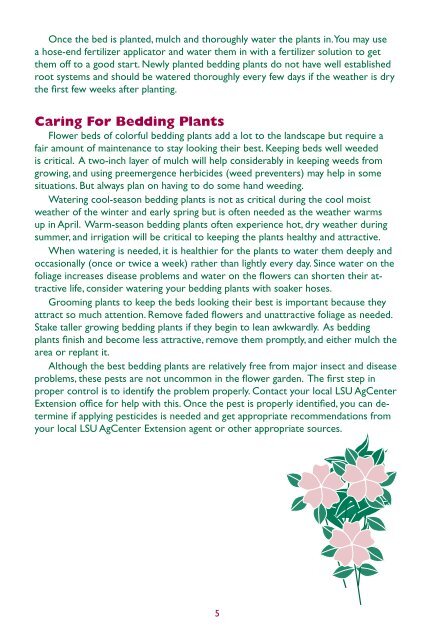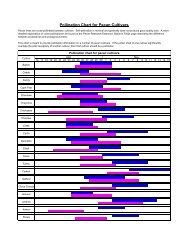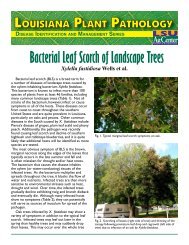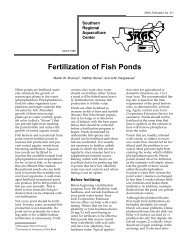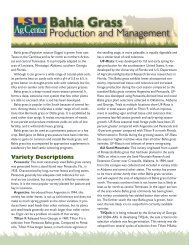Bedding Plants For Louisiana Landscapes - The LSU AgCenter
Bedding Plants For Louisiana Landscapes - The LSU AgCenter
Bedding Plants For Louisiana Landscapes - The LSU AgCenter
You also want an ePaper? Increase the reach of your titles
YUMPU automatically turns print PDFs into web optimized ePapers that Google loves.
Once the bed is planted, mulch and thoroughly water the plants in. You may use<br />
a hose-end fertilizer applicator and water them in with a fertilizer solution to get<br />
them off to a good start. Newly planted bedding plants do not have well established<br />
root systems and should be watered thoroughly every few days if the weather is dry<br />
the first few weeks after planting.<br />
Caring <strong>For</strong> <strong>Bedding</strong> <strong>Plants</strong><br />
Flower beds of colorful bedding plants add a lot to the landscape but require a<br />
fair amount of maintenance to stay looking their best. Keeping beds well weeded<br />
is critical. A two-inch layer of mulch will help considerably in keeping weeds from<br />
growing, and using preemergence herbicides (weed preventers) may help in some<br />
situations. But always plan on having to do some hand weeding.<br />
Watering cool-season bedding plants is not as critical during the cool moist<br />
weather of the winter and early spring but is often needed as the weather warms<br />
up in April. Warm-season bedding plants often experience hot, dry weather during<br />
summer, and irrigation will be critical to keeping the plants healthy and attractive.<br />
When watering is needed, it is healthier for the plants to water them deeply and<br />
occasionally (once or twice a week) rather than lightly every day. Since water on the<br />
foliage increases disease problems and water on the flowers can shorten their attractive<br />
life, consider watering your bedding plants with soaker hoses.<br />
Grooming plants to keep the beds looking their best is important because they<br />
attract so much attention. Remove faded flowers and unattractive foliage as needed.<br />
Stake taller growing bedding plants if they begin to lean awkwardly. As bedding<br />
plants finish and become less attractive, remove them promptly, and either mulch the<br />
area or replant it.<br />
Although the best bedding plants are relatively free from major insect and disease<br />
problems, these pests are not uncommon in the flower garden. <strong>The</strong> first step in<br />
proper control is to identify the problem properly. Contact your local <strong>LSU</strong> <strong>AgCenter</strong><br />
Extension office for help with this. Once the pest is properly identified, you can determine<br />
if applying pesticides is needed and get appropriate recommendations from<br />
your local <strong>LSU</strong> <strong>AgCenter</strong> Extension agent or other appropriate sources.


